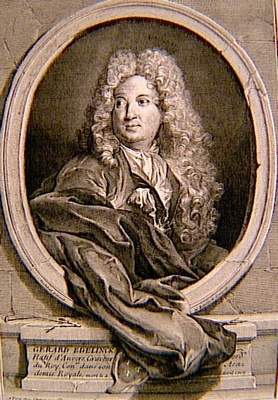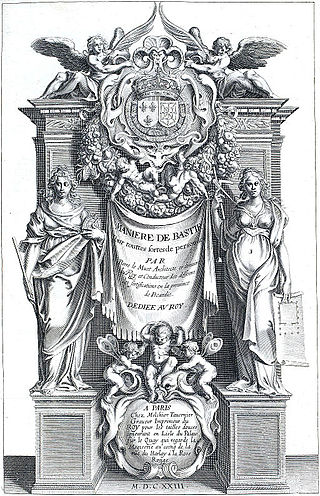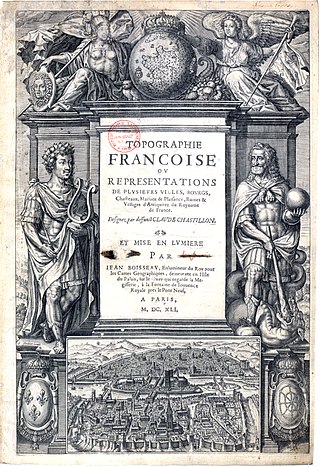
Melchior Tavernier (1594 – May 1665) was a French engraver, printmaker and print publisher.

Melchior Tavernier (1594 – May 1665) was a French engraver, printmaker and print publisher.
He was the son of Gabriel II Tavernier (1566–1607), [1] an engraver, who in 1573 moved with his father Gabriel I Tavernier (born Bailleul c. 1520; died 1614) and his brother Melchior Tavernier (born 1544 or 1564; died 1641) [2] from Antwerp to Paris. [3] [4] The younger Melchior Tavernier's mother was Suzanne Tonnelier. He had four siblings: Jean-Baptiste (who became a well-known writer and traveller), Gabriel III, Daniel, and Marie. His father, Gabriel II Tavernier, died in 1607; the inventory after his decease is dated 23 February 1607. [5] By a contract of 30 June 1609, the younger Melchior Tavernier apprenticed with Thomas de Leu for four years at the age of fourteen, and from this Préaud et al. concluded he was born in 1594 or 1595. [5] [6] According to the Haag Brothers, he was baptised in 1594. [7] It is often very difficult, with our current state of knowledge, to distinguish the work of the younger Melchior Tavernier from that of his uncle. [5]
In 1589, when the Catholic League occupied Paris, the Tavernier family had fled to Tours, where Henri IV's court and the Parlement of Paris ruled in exile; [8] the family lived there from 1590 to 1594. [5] French engraving was of lower quality compared to the Flemish school, and Protestants, such as the family of Gabriel I Tavernier, brought high quality copperplate engraving to France. The first atlas of France, Le Théâtre françois, où sont comprises les chartes générales et particulières de la France, was published in Tours in 1594 by Maurice Bouguereau . It contained twenty maps of the provinces of France, the engraving of which was done by Gabriel Tavernier. Bouguereau said that the opportunity to use a highly skilled engraver encouraged him to publish the atlas. [8] [9] [10]
After Gabriel I Tavernier returned to Paris, he resided on the Île du Palais, at 'L'Épi d'or', on the quai facing the Quai de la Mégisserie . After 1609 he was on the Pont Marchand , at the sign of 'La Huppe', parish of Saint-Barthélémy, where he remained in 1612. The elder Melchior Tavernier, who is otherwise obscure, claimed at a legal proceeding in 1620 that Gabriel I Tavernier introduced the art of etching to Paris and stated that his father died in 1614. On 7 December 1615, the assets of the elder Gabriel Tavernier's business and the lease for the house of 'La Huppe' on the Pont Marchand passed to the younger Melchior Tavernier's mother, Suzanne Tonnelier. [5]
In 1618 Melchior Tavernier became an intaglio engraver and printer to the king (graveur et imprimeur en taille-douce du Roi) with an emphasis on historical subjects and maps. [11] On 2 April 1619 he married Sarah Pitten and on 30 April he purchased from his mother the assets of the family business and took over the lease of its premises, 'La Huppe' on the Pont Marchand. The couple had at least three daughters (Suzanne, Marie-Madeleine and Marie-Catherine) who were still living on 16 March 1638, when an inventory was drawn up after the death of their mother. [5]
Abraham Bosse became an apprentice in the Tavernier shop in 1620, and Tavernier became one of his publishers. [12] Between 1623 and 1629 Ludolph Büsinck made woodcuts for Tavernier after drawings by Georges Lallemand. [13] Tavernier has an important place in the history of the French map trade. He published and sold maps and atlases of, among others, Henry Hondius, Jan Jansson, and Nicolas Tassin. [14] He also published, beginning in 1632, early works by Nicolas Sanson, often referred to as the founder of French cartography. [15]
Initially Tavernier continued to operate the shop at 'La Huppe' on the Pont Marchand but later moved to the Pont Notre-Dame 'à l'enseigne Franc Gaulois', then in 1621, to the Île du Palais, first at the corner of the rue de Harlay 'à la Rose rouge' and later on the quai facing the Quai de la Mégisserie 'à la Sphère royale' (1638 at the latest). [16] [17] [18] On 12 February 1644 he sold part of his assets to François Langlois for five million livres and the rest to Pierre Mariette (1596–1657), the grandfather of Jean Mariette, for eleven million. Retired from business, he bought the office of contrôleur et clerc d'office de la maison du duc d'Orléans. [5] [14]
By a contract of 24 April 1658 Tavernier married Jeanne Gobille, sister of Gédéon Gobille, a seller of etchings. An illness in 1661 incapacitated Tavernier, and in May 1665 his wife had a document drawn up before a notary to protect her interests. Tavernier died shortly after: the inventory after his decease is dated 25 May 1665. [16]
Works that he published include:

Albert Auguste Gabriel Hanotaux, known as Gabriel Hanotaux was a French statesman and historian.

Abraham Bosse was a French artist, mainly as a printmaker in etching, but also in watercolour.

Gérard Edelinck was a copper-plate engraver and print publisher of Flemish origin, who worked in Paris from 1666 and became a naturalized French citizen in 1675.

Robert Nanteuil was a French portrait artist: engraver, draughtsman and pastellist to the court of Louis XIV.

Claude Mellan was a French draughtsman, engraver, and painter.

Pierre Le Muet was a French architect, military engineer, and writer, famous for his book Manière de bâtir pour toutes sortes de personnes, and for the châteaux he constructed, most notably Tanlay in Burgundy, as well as some modest houses in Paris, the grandest of which, the Hôtel d'Avaux (1644–1650) survives and has recently been restored to a semblance of its seventeenth-century condition.

Giacomo Torelli was an Italian stage designer, scenery painter, engineer, and architect. His work in stage design, particularly his designs of machinery for creating spectacular scenery changes and other special effects, was extensively engraved and hence survives as the most complete record of mid-seventeenth-century set design.

Pierre Lepautre or Le Pautre was a French draughtsman, engraver and architect, especially known as an ornemaniste, a prolific designer of ornament that presages the coming Rococo style. He was the son of the designer and engraver Jean Lepautre and nephew of the architect Antoine Lepautre. His appointment in 1699 as Dessinateur in the Bâtiments du Roi, the official design department of the French monarchy, headed by Jules Hardouin-Mansart and later Robert de Cotte in the declining years of Louis XIV, was signalled by the historian of the Rococo, Fiske Kimball, as a starting point in the genesis of the new style.

Nicolas-Jean-Baptiste Raguenet was a French painter born in Gentilly.

The Merian map of Paris was created in 1615 by Matthäus Merian, the map presents a "bird's eye view" looking east with a scale of about 1 to 7,000. It originally consisted of two engraved plates with the left and right halves of the map and was printed with 2 columns of portraits on the left and right sides of the respective map halves. The entire assembly was 50 x 101.5 cm.
Thomas de Leu or Leeuw or Le Leup or Deleu (1560–1612) was a French engraver, publisher, and print dealer of Flemish origin.
Jean-François Cars, was a French engraver, printer, publisher and printseller from Lyon.
Jollain was the name of a family of French engravers and engraving publishers who lived and worked in the 17th and 18th centuries, mainly in Paris. Their engravings were often published under the name Chez Jollain. The atelier Jollain was responsible for the first engraving of harpsichord music in France.

Nicolas-Étienne Edelinck was a French engraver, was born to a family of engravers in Paris, the eighth son of Gérard Edelinck. Although he had the advantage of his father's instruction, and of studying in Italy, he never rose above mediocrity. He engraved some portraits, and a few plates for the Crozat Collection. He died in Paris in 1768. Among other prints by him are the following:

François L’Anglois or Langlois, also called F. L. D. Ciartres, was a French print publisher, print seller, engraver, bookseller, art dealer, and painter. He is widely considered to have been the first important print publisher in France and to have contributed significantly to spreading awareness of contemporary artists' work throughout Europe.

Pierre Vallet was a French botanical artist, engraver and embroidery designer. He worked as a "Brodeur ordinaire du Roy" in the court of Marie de Medicis of Florence, second wife of Henry IV of France. Vallet made botanical illustrations, along with Jean Robin, for the Le Jardin du tres Chrestien Henry IV (1608) with plants from the garden of the Louvre Palace along with exotic curiosities from West Africa and Spain.
Paul Androuet du Cerceau (1623–1710), was a French goldsmith and engraver, who was active in Paris around 1610. According to Benezit, Reynaud presumes he is the son of the architect Jean Baptiste Androuet du Cerceau, who built the Pont Neuf in Paris, but Paul is now believed to be the grandson of Jacques II Androuet du Cerceau.

Jacques Lepautre or Le Pautre was a Parisian engraver active during the last quarter of the seventeenth century. Jacques was the son of the prolific printmaker Jean Lepautre (1618–1682) and nephew of architect Antoine Lepautre (1621–1679).

Claude Chastillon or Chatillon was a French architect, military and civil engineer, and topographical draughtsman, who served under Henry IV of France. His most notable work, Topographie françoise, published posthumously in 1641, is a collection of 500 views of French towns and buildings and constitutes a unique, if partial, historical account of French topography and architecture at the beginning of the 17th century.

Thibault Métezeau or Thibaut Métezeau was a French architect. He was the son of Clément Métezeau, master mason and father of architects Louis and Clément II Métezeau. He was the younger brother of Jean Métezeau, also an architect.